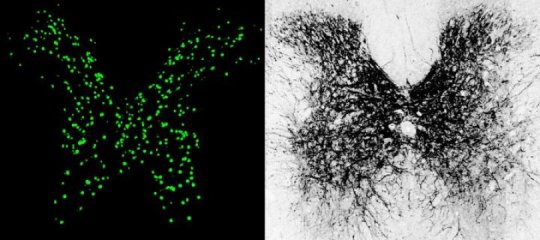[ad_1]
Most people with spinal cord injury are paralyzed from the injury site down, even when the cord isn’t completely severed. Why don’t the spared portions of the spinal cord keep working? Researchers at Boston Children’s Hospital now provide insight into why these nerve pathways remain quiet. They also show that a small-molecule compound, given systemically, can revive these circuits in paralyzed mice, restoring their ability to walk.
The study, led by Zhigang He, PhD, in Boston Children’s F.M. Kirby Neurobiology Center, was published online July 19 by the journal Cell.
“For this fairly severe type of spinal cord injury, this is most significant functional recovery we know of,” says He. “We saw 80 percent of mice treated with this compound recover their stepping ability.”
Waking up dormant spinal circuits
Many animal studies looking to repair spinal cord damage have focused on getting nerve fibers, or axons, to regenerate, or to getting new axons to sprout from healthy ones. While impressive axon regeneration and sprouting have been achieved, by He’s lab and others, their impacts on the animals’ motor function after a severe injury are less clear. Some studies have tried using neuromodulators such as serotonergic drugs to simulate the spinal circuits, but have gotten only transient, uncontrolled limb movement.
He and colleagues took another approach, inspired by the success of epidural electrical stimulation-based strategies, the only treatment known to be effective in patients with spinal cord injury. This treatment applies a current to the lower portion of the spinal cord; combined with rehabilitation training, it has enabled some patients to regain movement.
“Epidural stimulation seems to affect the excitability of neurons,” says He. “However, in these studies, when you turn off the stimulation, the effect is gone. We tried to come up with a pharmacologic approach to mimic the stimulation and better understand how it works.”
He, first author Bo Chen and colleagues selected a handful of compounds that are already known to alter the excitability of neurons, and are able to cross the blood-brain barrier. They gave each compound to paralyzed mice in groups of 10 via intraperitoneal injection. All mice had severe spinal cord injury, but with some nerves intact. Each group (plus a control group given placebo) was treated for eight to ten weeks.
Inhibiting inhibition by re-activating KCC2
One compound, called CLP290, had the most potent effect, enabling paralyzed mice to regain stepping ability after four to five weeks of treatment. Electromyography recordings showed that the two relevant groups of hindlimb muscles were active. The animals’ walking scores remained higher than the controls’ up to two weeks after stopping treatment. Side effects were minimal.
CLP290 is known to activate a protein called KCC2, found in cell membranes, that transports chloride out of neurons. The new research shows that inhibitory neurons in the injured spinal cord are crucial to recovery of motor function. After spinal cord injury, these neurons produce dramatically less KCC2. As a result, He and colleagues found, they can’t properly respond to signals from the brain. Unable to process inhibitory signals, they respond only to excitatory signals that tell them to keep firing. And since these neurons’ signals are inhibitory, the result is too much inhibitory signaling in the overall spinal circuit. In effect, the brain’s commands telling the limbs to move aren’t relayed.
By restoring KCC2, with either CLP290 or genetic techniques, the inhibitory neurons can again receive inhibitory signals from the brain, so they fire less. This shifts the overall circuit back toward excitation, the researchers found, making it more responsive to input from the brain. This had the effect of reanimating spinal circuits disabled by the injury.
“Restoring inhibition will allow the whole system to be excited more easily,” He explains.
“Too much excitation not good, and too much inhibition is not good either. You really need to get a balance. This hasn’t been demonstrated in a rigorous way in spinal cord injury before.”
Combination treatment?
He and colleagues are now investigating other compounds that act as KCC2 agonists. They believe such drugs, or perhaps gene therapy to restore KCC2, could be combined with epidural stimulation to maximize a patient’s function after spinal cord injury.
“We are very excited by this direction,” says He. “We want to test this kind of treatment in a more clinically relevant model of spinal cord injury and better understand how KCC2 agonists work.”
Bo Chen, Yi Li (Boston Children’s Hospital) and Bin Yu (Nantong University, China) were co-first authors on the paper. Xiosong Gu (Nantong University) and Zhigang He are co-senior authors. Coauthors were Zicong Zhang, Benedikt Brommer, Philip Raymond Williams, Yuanyuan Liu, Shane Vincent Hegarty, Junjie Zhu and Yiming Zhang (Boston Children’s Hospital); Songlin Zhou (Nantong University); Hong Guo and Yi Lu (Brigham and Women’s Hospital, Boston).
The study was supported by the National Major Project of Research and Development of China (2017YFA0104701), the National Institute of Neurological Disorders and Stroke (NS096294), the Craig Neilsen Foundation, the Paralyzed Veterans of America Research Foundation and the Dr. Miriam and Sheldon G. Adelson Medical Research Foundation.
[ad_2]















